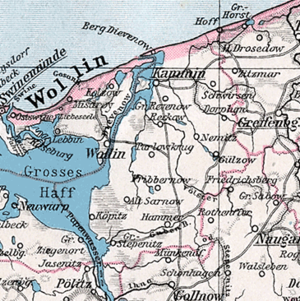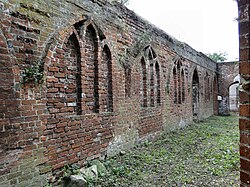Jasienica (Police)
Jasienica (German Jasenitz ) is a place in the Polish West Pomeranian Voivodeship . It forms a district of the city of Police ( Pölitz ).

Geographical location
The place is located in eastern Western Pomerania , about 15 km north of Stettin , and west of the Oder in the so-called Stettiner Zipfel , i.e. in the part of Western Pomerania that was placed under Polish administration in 1945.
The Gunica ( Aalbach ) flows from west to east through the place, which lies on the west bank of the Papenwasser of the Stettiner Haff , and flows east of the place into the Oder.
The Szczecin – Trzebież Szczeciński railway ( Stettin – Ziegenort railway ) runs west of the town center .
history


The village of Jasenitz was first mentioned in 1260. In 1299 the owners of the village built the first church, which became a branch church of Pölitz . The place name is derived from the Slavic word Jassen for ash , which indicates that ash forests were predominant here when the village was founded.
In 1305 the Augustinian Canons' Monastery, founded in Ueckermünde in 1260, acquired the village of Jasenitz from Duke Otto I of Pomerania. Around 1329 the monastery moved its seat to Jasenitz. After the monastery existed for two hundred years, it fell into disrepute because the friars did not adhere to the rules of the order. Not long after 1486, Duke Bogislaw X. took action , dismissed the existing friars and replaced them with regular canons headed by Abbas from Möllenbeck Abbey on the Weser. The monastery remained until it was dissolved after 1535 as part of the Reformation .
In the course of the Reformation , the monastery buildings came into the possession of the Pomeranian dukes Barnim IX. and Philip I. In the presence of a large number of lieutenants and councilors, the dukes negotiated on October 25, 1543 in Jasenitz about the foundation of a higher school and signed the charter for the princely pedagogy in Stettin, the later Marienstiftsgymnasium . In 1569 a new division of the estate between the Pomeranian dukes was decided in Jasenitz.
The former monastery on the Marienberg now became the seat of a princely domain office. The main building was expanded like a castle and used by the dukes as a hunting lodge. During the Thirty Years' War was the monastery badly damaged, but during the Swedish period it has been restored. From 1774 Princess Elisabeth , the divorced wife of Friedrich Wilhelm II exiled to Stettin , had her summer residence here. A part of the former monastery church was used as the local church after the Reformation. The late Gothic Marienkirche received a newly built choir closure in 1858.
Around 1775 there was a preacher in the village of Jasenitz, 13 farmers, 38 Büdner, most of whom were boatmen, sailors, fishermen and a few craftsmen, a sexton, a miller, a cutter, a shepherd and a brewer. On the outskirts of the village there was a Vorwerk with a brewery and distillery, a tar oven and a water mill.
In 1811 the Prussian state sold the Jasenitz estate to Hans Georg Alexander Friedrich von Köller , the general landscape director of the Pomeranian landscape. The previous sovereign domain now received the rights of a manor . Matthias von Köller took over the Jasenitz estate after his father's death in 1820, but sold it in 1837.
On January 1, 1862, the village of Jasenitz, without the castle estate, had 1,267 inhabitants who lived in 258 families.
Around 1930 the district of Jasenitz, where Jasenitz was the only place to live, had an area of 5.1 km²; In 1925, 1,779 inhabitants were counted, which were distributed over 504 households.
The rural community Jasenitz belonged to the Randow district in the province of Pomerania until 1939 . With the dissolution of the Randow district, Jasenitz came to the Ueckermünde district in 1939 .
Jasenitz has been under Polish administration since 1945 and is now part of Poland. The Polish state gave the place the name Jasienica . Polish resettlers were settled in place of the German population . Jasienica was incorporated into the city of Police ( Pölitz ) after 1946 .
Development of the population
- 1862: 1,267 (excluding the castle estate), of which four are Catholics and eight are Jews
- 1925: 1,779, 17 of them Catholics and one Jew
- 1933: 3.257
- 1939: 3,488
religion
The majority of the population present in Jasenitz before 1945 belonged to the Protestant creed; in 1925 there were 17 Catholics and one Jew in addition to the Protestants.
Attractions
- Ruins of the Jasenitz monastery
- Marienkirche
Sons and daughters of the place
- Georg von Köller (1823–1916), German politician (Conservative Party), President of the Prussian House of Representatives
- Hans Modrow (* 1928), German politician (SED / PDS / Left), chairman of the GDR Council of Ministers
- Andreas Bogdain (* 1959), German artist
literature
- Ernst Bahr, Klaus Conrad: Jasenitz . In: Helge bei der Wieden , Roderich Schmidt (Hrsg.): Handbook of the historical sites of Germany . Volume 12: Mecklenburg / Pomerania (= Kröner's pocket edition . Volume 315). Kröner, Stuttgart 1996, ISBN 3-520-31501-7 , pp. 209-210.
- Johannes Hinz : Pomerania. Signpost through an unforgettable country. Flechsig-Buchvertrieb, Würzburg 2002, ISBN 3-88189-439-X , p. 163.
- Heinrich Berghaus : Land book of the Duchy of Pomerania and the Principality of Rügen . Part II, Volume 2, Anklam 1865, pp. 1856–1857 ( online ) and pp. 1602–1607 ( online )
- Ludwig Wilhelm Brüggemann : Detailed description of the current state of the Königl. Prussian Duchies of Western and Eastern Pomerania . Part I: General introduction and description of the Prussian Western Pomerania , Stettin 1779, pp. 206–207, No. 7 ( online )
Footnotes
- ↑ a b c d Heinrich Berghaus : Land book of the Duchy of Pomerania and the Principality of Rügen . Part II, Volume 2, Anklam 1865, pp. 1602-1607.
- ^ Heinrich Berghaus : Land book of the Duchy of Pomerania and the Principality of Rügen . Part II, Volume 1, Anklam 1865, p. 920.
- ↑ Martin Wehrmann : Festschrift for the three hundred and fifty year anniversary of the Royal Marienstift High School in Stettin on September 24 and 25, 1894. Herrcke & Lebeling, Stettin 1894, p. 12f.
- ^ Hermann Hoogeweg : The founders and monasteries of the province of Pomerania. Vol. 2, Stettin 1925, p. 94.
- ↑ Berghaus information in Landbuch II, p. 1604, according to which a pedagogy was opened in Jasenitz in 1543, which existed for 40 years and was then moved to Stettin, is based on an error. Wehrmann: Festschrift p. 12, Hoogeweg: Klöster 2, p. 94.
- ↑ Günter Linke, The Pomeranian territories of the 16th century, Stettin 1935.
- ↑ Ludwig Wilhelm Brüggemann : Detailed description of the current state of the Königl. Prussian Duchies of Western and Eastern Pomerania . Part I: General introduction and description of the Prussian Western Pomerania , Stettin 1779, pp. 206-207, No. 7.
- ↑ Brüggemann (1779), p. 210, No. 3.
- ↑ Brüggemnann (1779), p. 212, No. 4 (4).
- ↑ Brüggemann (1779), p. 212, No. 5 (5).
- ^ A b Heinrich Berghaus : Land book of the Duchy of Pomerania and the Principality of Rügen . Part II, Volume 2, Anklam 1865, pp. 1856-1857.
- ↑ a b c Gunthard Stübs and Pommersche Forschungsgemeinschaft: The community of Jasenitz in the former Randow district in Pomerania (2011).
- ^ A b Michael Rademacher: German administrative history from the unification of the empire in 1871 to the reunification in 1990. Landkreis Randow. (Online material for the dissertation, Osnabrück 2006).
Coordinates: 53 ° 36 ' N , 14 ° 32' E


